check engine RENAULT SCENIC 2009 J84 / 2.G Engine And Peripherals EDC16 Workshop Manual
[x] Cancel search | Manufacturer: RENAULT, Model Year: 2009, Model line: SCENIC, Model: RENAULT SCENIC 2009 J84 / 2.GPages: 273
Page 229 of 273
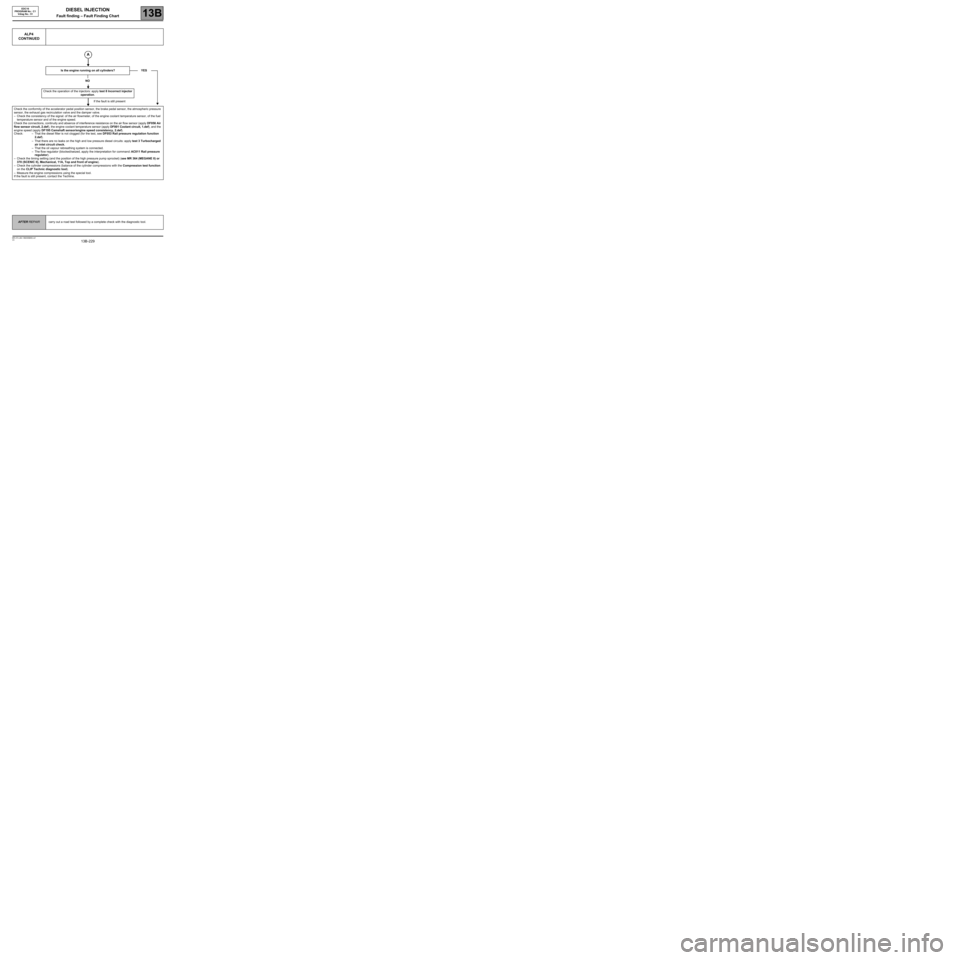
DIESEL INJECTION
Fault finding – Fault Finding Chart13B
13B -229V3 MR-372-J84-13B250$855.mif
ALP4
CONTINUED
Is the engine running on all cylinders?
NO
Check the operation of the injectors: apply test 8 Incorrect injector
operation.
If the fault is still present
Check the conformity of the accelerator pedal position sensor, the brake pedal sensor, the atmospheric pressure
sensor, the exhaust gas recirculation valve and the damper valve.
–Check the consistency of the signal: of the air flowmeter, of the engine coolant temperature sensor, of the fuel
temperature sensor and of the engine speed.
Check the connections, continuity and absence of interference resistance on the air flow sensor (apply DF056 Air
flow sensor circuit, 2.def), the engine coolant temperature sensor (apply DF001 Coolant circuit, 1.def), and the
engine speed (apply DF195 Camshaft sensor/engine speed consistency, 2.def).
Check: – That the diesel filter is not clogged (for the test, see DF053 Rail pressure regulation function
2.def).
–That there are no leaks on the high and low pressure diesel circuits: apply test 3 Turbocharged
air inlet circuit check.
–That the oil vapour rebreathing system is connected.
–The flow regulator (blocked/seized, apply the interpretation for command: AC011 Rail pressure
regulator).
–Check the timing setting (and the position of the high pressure pump sprocket) (see MR 364 (MEGANE II) or
370 (SCENIC II), Mechanical, 11A, Top and front of engine).
–Check the cylinder compressions (balance of the cylinder compressions with the Compression test function
on the CLIP Technic diagnostic tool).
–Measure the engine compressions using the special tool.
If the fault is still present, contact the Techline.YES
EDC16
PROGRAM No.: C1
Vdiag No.: 51
AFTER REPAIRcarry out a road test followed by a complete check with the diagnostic tool.
Page 230 of 273
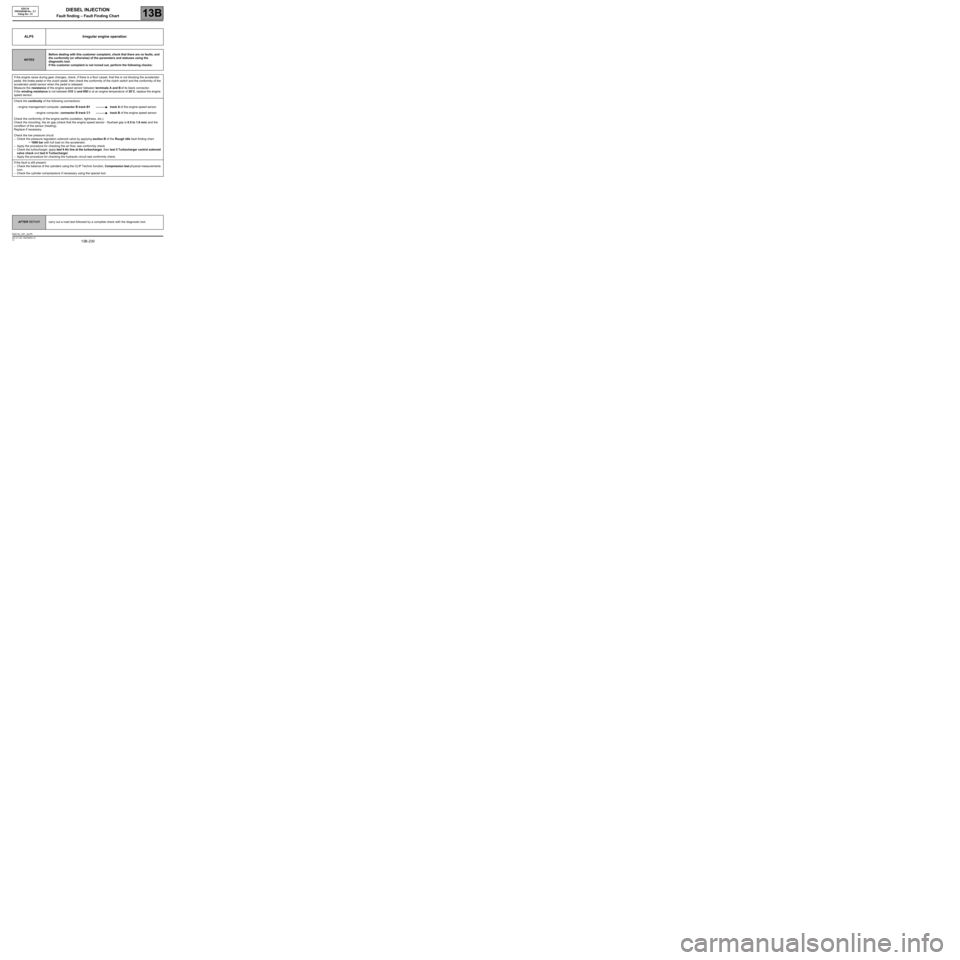
DIESEL INJECTION
Fault finding – Fault Finding Chart13B
13B -230V3 MR-372-J84-13B250$855.mif
EDC16
PROGRAM No.: C1
Vdiag No.: 51
ALP5 Irregular engine operation
NOTESBefore dealing with this customer complaint, check that there are no faults, and
the conformity (or otherwise) of the parameters and statuses using the
diagnostic tool.
If the customer complaint is not ironed out, perform the following checks:
If the engine races during gear changes, check, if there is a floor carpet, that this is not blocking the accelerator
pedal, the brake pedal or the clutch pedal, then check the conformity of the clutch switch and the conformity of the
accelerator pedal sensor when the pedal is released.
Measure the resistance of the engine speed sensor between terminals A and B of its black connector.
If the winding resistance is not between 510 Ω and 850 Ω at an engine temperature of 20˚C, replace the engine
speed sensor.
Check the continuity of the following connections:
–engine management computer, connector B track B1 track A of the engine speed sensor
–engine computer, connector B track C1 track B of the engine speed sensor
Check the conformity of the engine earths (oxidation, tightness, etc.).
Check the mounting, the air gap (check that the engine speed sensor - flywheel gap is 0.5 to 1.8 mm) and the
condition of the sensor (heating).
Replace if necessary.
Check the low pressure circuit.
–Check the pressure regulation solenoid valve by applying section B of the Rough idle fault finding chart.
~ 1600 bar with full load on the accelerator.
–Apply the procedure for checking the air flow; see conformity check.
–Check the turbocharger: apply test 9 Air line at the turbocharger, then test 5 Turbocharger control solenoid
valve check and test 6 Turbocharger.
–Apply the procedure for checking the hydraulic circuit see conformity check.
If the fault is still present:
–Check the balance of the cylinders using the CLIP Technic function, Compression test physical measurements
icon.
–Check the cylinder compressions if necessary using the special tool.
AFTER REPAIRcarry out a road test followed by a complete check with the diagnostic tool.
EDC16_V51_ALP5
Page 231 of 273
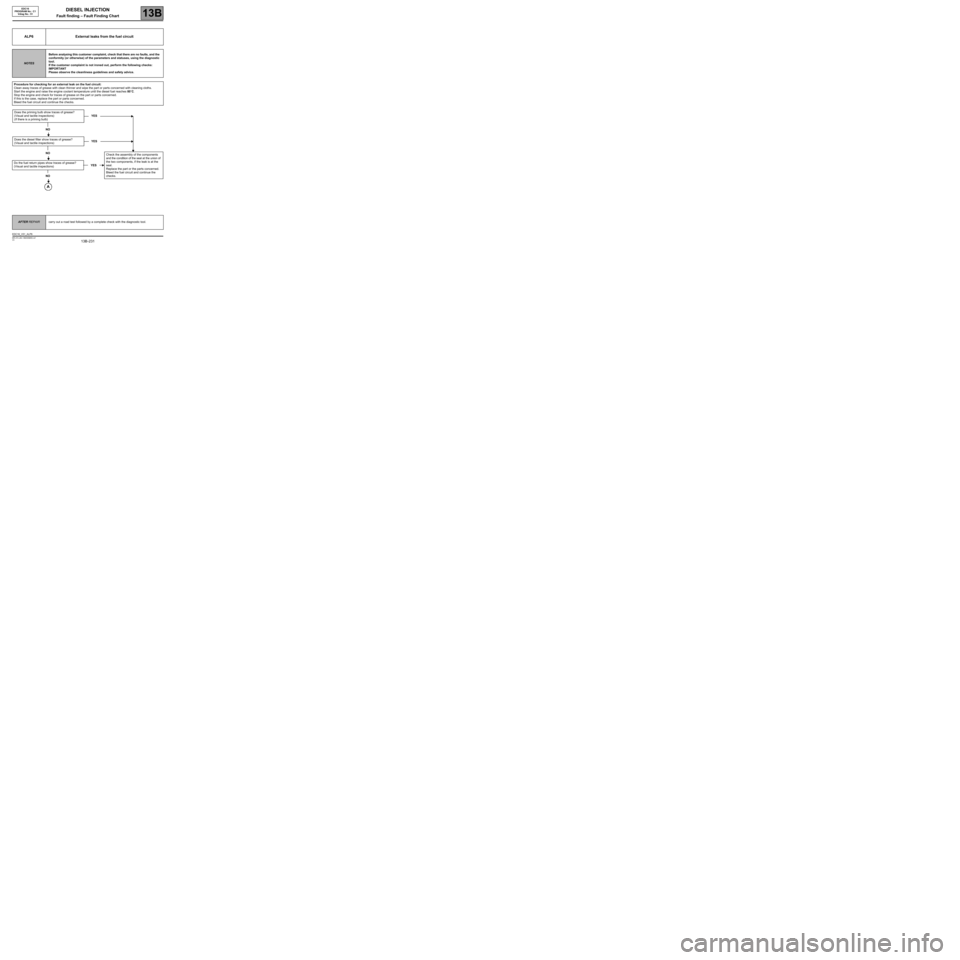
DIESEL INJECTION
Fault finding – Fault Finding Chart13B
13B -231V3 MR-372-J84-13B250$855.mif
EDC16
PROGRAM No.: C1
Vdiag No.: 51
ALP6 External leaks from the fuel circuit
NOTESBefore analysing this customer complaint, check that there are no faults, and the
conformity (or otherwise) of the parameters and statuses, using the diagnostic
tool.
If the customer complaint is not ironed out, perform the following checks:
IMPORTANT
Please observe the cleanliness guidelines and safety advice.
Procedure for checking for an external leak on the fuel circuit:
Clean away traces of grease with clean thinner and wipe the part or parts concerned with cleaning cloths.
Start the engine and raise the engine coolant temperature until the diesel fuel reaches 80˚C.
Stop the engine and check for traces of grease on the part or parts concerned.
If this is the case, replace the part or parts concerned.
Bleed the fuel circuit and continue the checks.
Does the priming bulb show traces of grease?
(Visual and tactile inspections)
(If there is a priming bulb)YES
NO
Does the diesel filter show traces of grease?
(Visual and tactile inspections)YES
NO
Do the fuel return pipes show traces of grease?
(Visual and tactile inspections)
NO
YESCheck the assembly of the components
and the condition of the seal at the union of
the two components, if the leak is at the
seal.
Replace the part or the parts concerned.
Bleed the fuel circuit and continue the
checks.
AFTER REPAIRcarry out a road test followed by a complete check with the diagnostic tool.
EDC16_V51_ALP6
Page 233 of 273
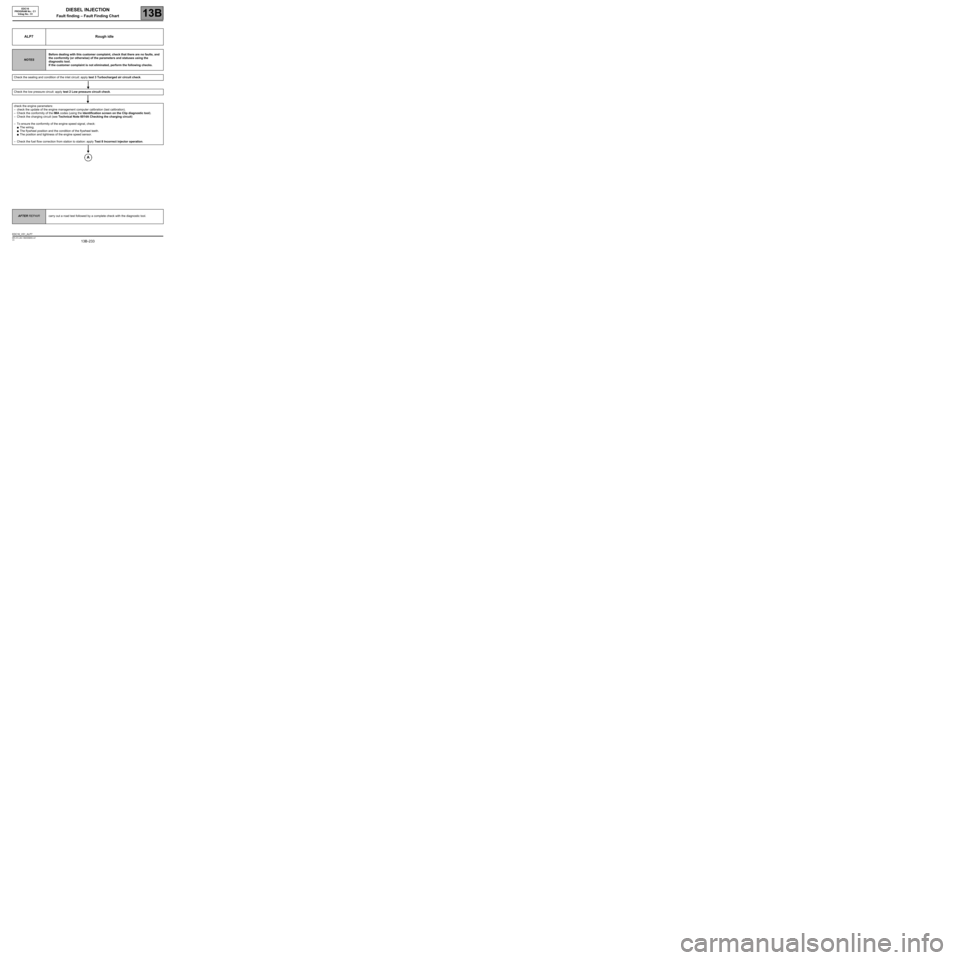
DIESEL INJECTION
Fault finding – Fault Finding Chart13B
13B -233V3 MR-372-J84-13B250$855.mif
EDC16
PROGRAM No.: C1
Vdiag No.: 51
ALP7 Rough idle
NOTESBefore dealing with this customer complaint, check that there are no faults, and
the conformity (or otherwise) of the parameters and statuses using the
diagnostic tool.
If the customer complaint is not eliminated, perform the following checks.
Check the sealing and condition of the inlet circuit: apply test 3 Turbocharged air circuit check.
Check the low pressure circuit: apply test 2 Low pressure circuit check.
check the engine parameters:
–check the update of the engine management computer calibration (last calibration).
–Check the conformity of the IMA codes (using the Identification screen on the Clip diagnostic tool).
–Check the charging circuit (see Technical Note 6014A Checking the charging circuit)
–To ensure the conformity of the engine speed signal, check:
●The wiring.
●The flywheel position and the condition of the flywheel teeth.
●The position and tightness of the engine speed sensor.
–Check the fuel flow correction from station to station: apply Test 8 Incorrect injector operation.
AFTER REPAIRcarry out a road test followed by a complete check with the diagnostic tool.
EDC16_V51_ALP7
Page 234 of 273
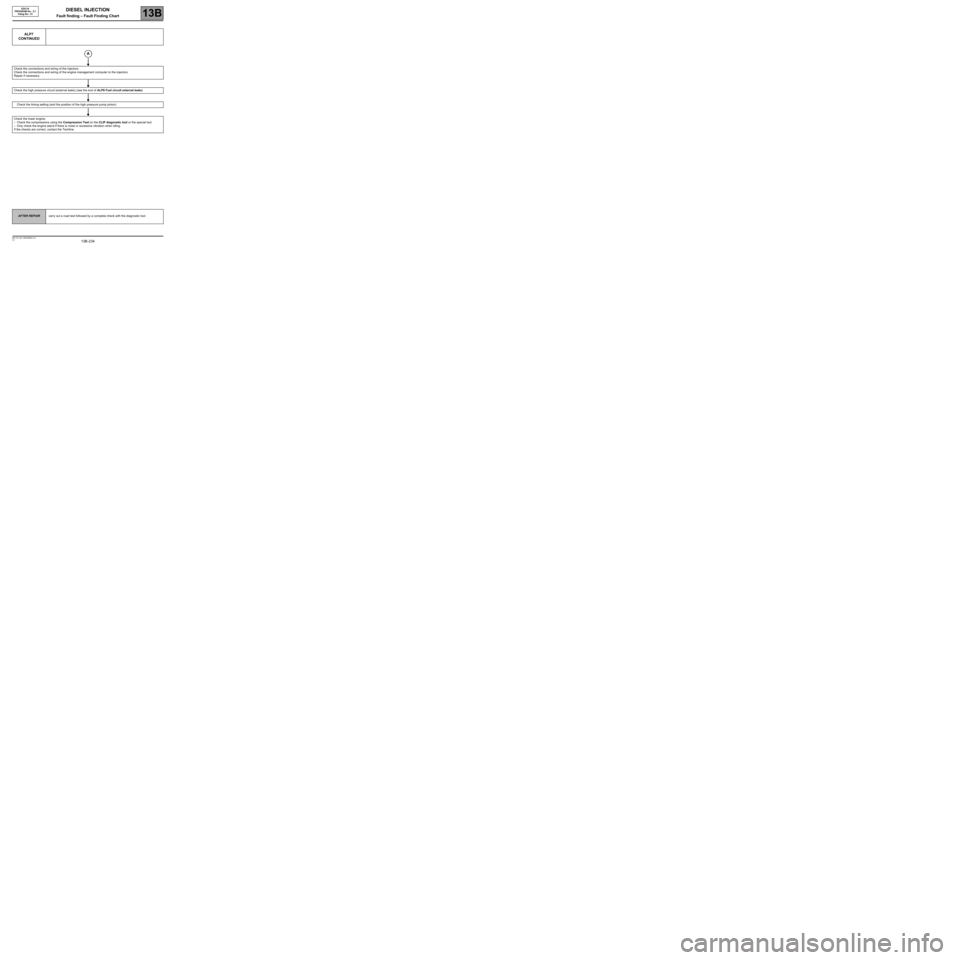
DIESEL INJECTION
Fault finding – Fault Finding Chart13B
13B -234V3 MR-372-J84-13B250$855.mif
EDC16
PROGRAM No.: C1
Vdiag No.: 51
ALP7
CONTINUED
Check the connections and wiring of the injectors.
Check the connections and wiring of the engine management computer to the injectors.
Repair if necessary.
Check the high pressure circuit (external leaks) (see the end of ALP6 Fuel circuit external leaks)
Check the timing setting (and the position of the high pressure pump pinion)
Check the lower engine:
–Check the compressions using the Compression Test on the CLIP diagnostic tool or the special tool.
–Only check the engine stand if there is noise or excessive vibration when idling.
If the checks are correct, contact the Techline.
AFTER REPAIRcarry out a road test followed by a complete check with the diagnostic tool.
Page 235 of 273
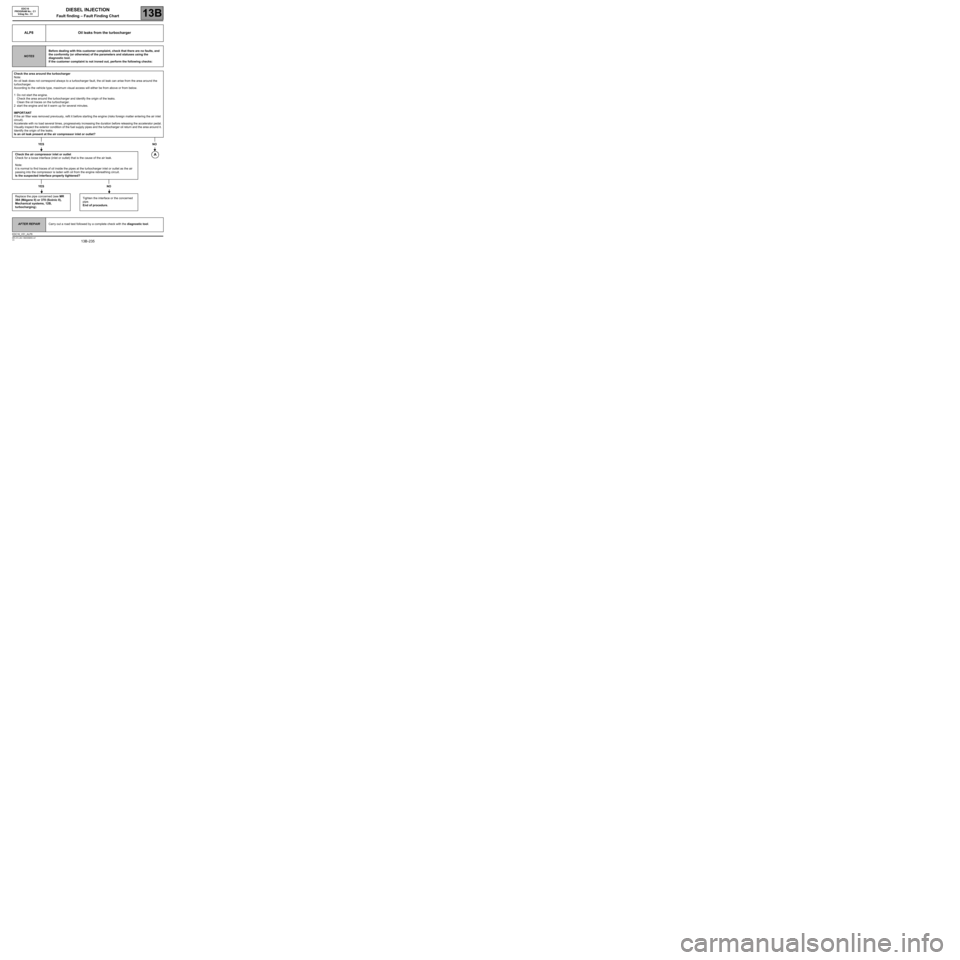
DIESEL INJECTION
Fault finding – Fault Finding Chart13B
13B -235V3 MR-372-J84-13B250$855.mif
ALP8 Oil leaks from the turbocharger
NOTESBefore dealing with this customer complaint, check that there are no faults, and
the conformity (or otherwise) of the parameters and statuses using the
diagnostic tool.
If the customer complaint is not ironed out, perform the following checks:
Check the area around the turbocharger
Note:
An oil leak does not correspond always to a turbocharger fault, the oil leak can arise from the area around the
turbocharger.
According to the vehicle type, maximum visual access will either be from above or from below.
1Do not start the engine.
Check the area around the turbocharger and identify the origin of the leaks.
Clean the oil traces on the turbocharger.
2start the engine and let it warm up for several minutes.
IMPORTANT
If the air filter was removed previously, refit it before starting the engine (risks foreign matter entering the air inlet
circuit).
Accelerate with no load several times, progressively increasing the duration before releasing the accelerator pedal.
Visually inspect the exterior condition of the fuel supply pipes and the turbocharger oil return and the area around it.
Identify the origin of the leaks.
Is an oil leak present at the air compressor inlet or outlet?
YESNO
Check the air compressor inlet or outlet
Check for a loose interface (inlet or outlet) that is the cause of the air leak.
Note:
it is normal to find traces of oil inside the pipes at the turbocharger inlet or outlet as the air
passing into the compressor is laden with oil from the engine rebreathing circuit.
Is the suspected interface properly tightened?
YES NO
Replace the pipe concerned (see MR
364 (Mégane II) or 370 (Scénic II),
Mechanical systems, 12B,
turbocharging).Tighten the interface or the concerned
pipe.
End of procedure.
AFTER REPAIRCarry out a road test followed by a complete check with the diagnostic tool.
EDC16
PROGRAM No.: C1
Vdiag No.: 51
EDC16_V51_ALP8
Page 236 of 273
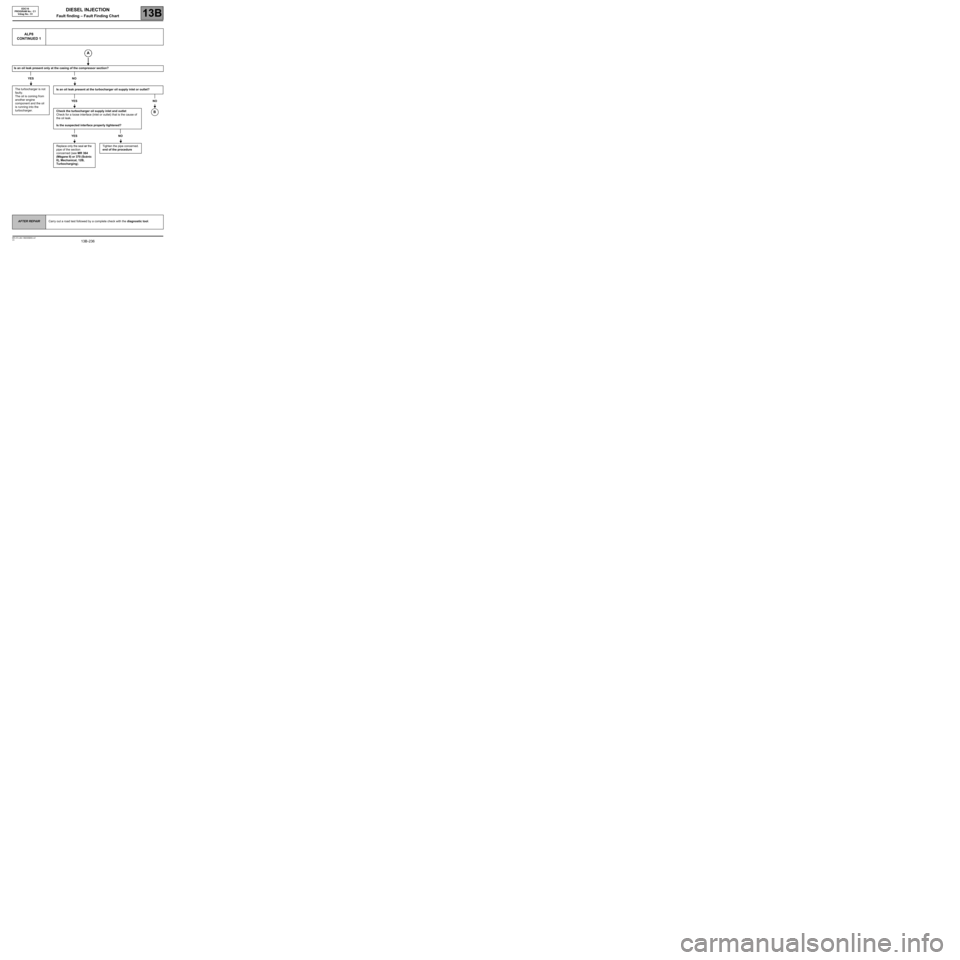
DIESEL INJECTION
Fault finding – Fault Finding Chart13B
13B -236V3 MR-372-J84-13B250$855.mif
EDC16
PROGRAM No.: C1
Vdiag No.: 51
ALP8
CONTINUED 1
Is an oil leak present only at the casing of the compressor section?
YES NO
The turbocharger is not
faulty.
The oil is coming from
another engine
component and the oil
is running into the
turbocharger.Is an oil leak present at the turbocharger oil supply inlet or outlet?
YES NO
Check the turbocharger oil supply inlet and outlet
Check for a loose interface (inlet or outlet) that is the cause of
the oil leak.
Is the suspected interface properly tightened?
YES NO
Replace only the seal or the
pipe of the section
concerned (see MR 364
(Mégane II) or 370 (Scénic
II), Mechanical, 12B,
Turbocharging).Tighten the pipe concerned.
end of the procedure
B
AFTER REPAIRCarry out a road test followed by a complete check with the diagnostic tool.
Page 237 of 273
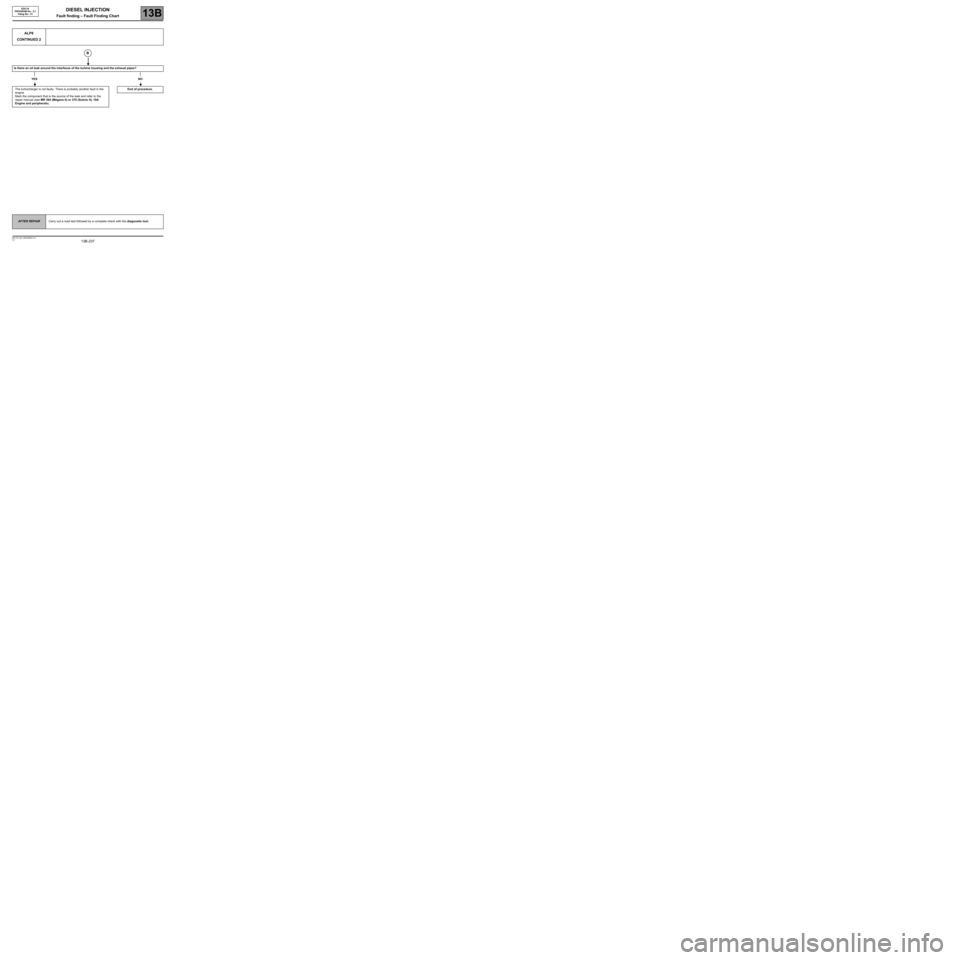
DIESEL INJECTION
Fault finding – Fault Finding Chart13B
13B -237V3 MR-372-J84-13B250$855.mif
EDC16
PROGRAM No.: C1
Vdiag No.: 51
ALP8
CONTINUED 2
Is there an oil leak around the interfaces of the turbine housing and the exhaust pipes?
YESNO
The turbocharger is not faulty. There is probably another fault in the
engine.
Mark the component that is the source of the leak and refer to the
repair manual (see MR 364 (Mégane II) or 370 (Scénic II), 10A
Engine and peripherals).End of procedure.
B
AFTER REPAIRCarry out a road test followed by a complete check with the diagnostic tool.
Page 239 of 273
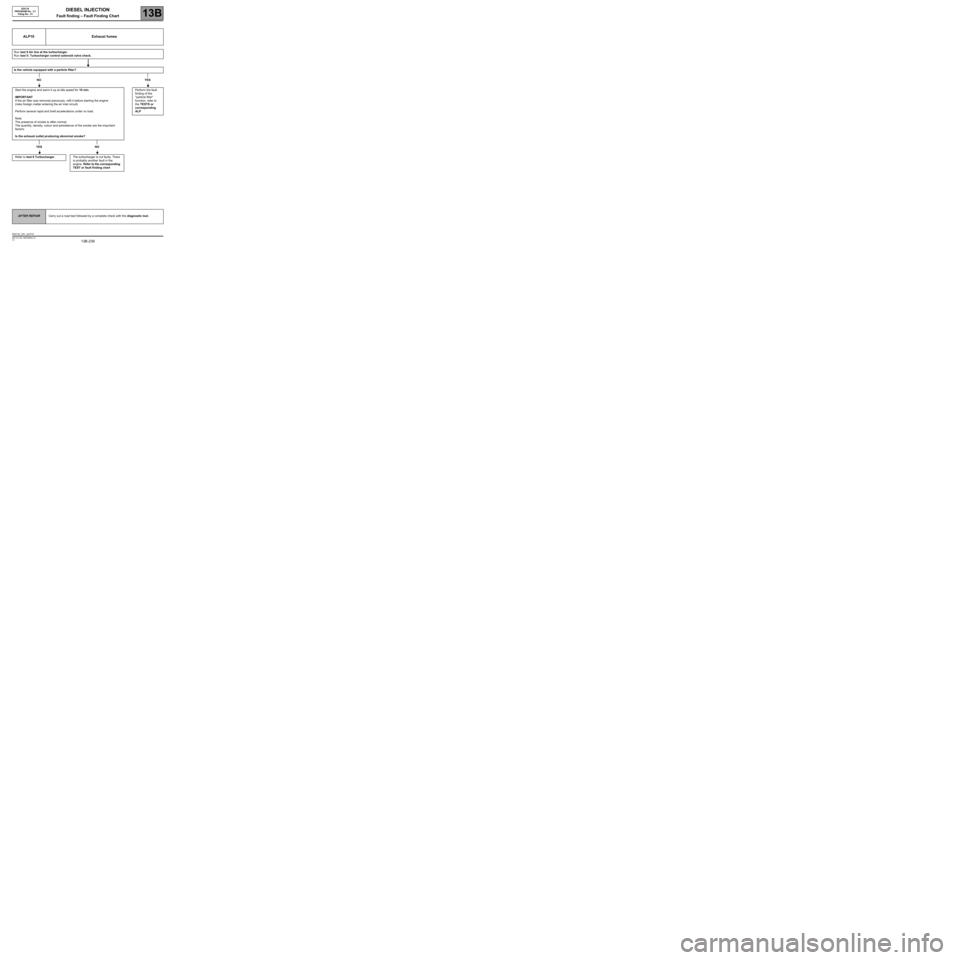
DIESEL INJECTION
Fault finding – Fault Finding Chart13B
13B -239V3 MR-372-J84-13B250$855.mif
EDC16
PROGRAM No.: C1
Vdiag No.: 51
ALP10 Exhaust fumes
Run test 9 Air line at the turbocharger.
Run test 5: Turbocharger control solenoid valve check.
Is the vehicle equipped with a particle filter?
NOYES
Start the engine and warm it up at idle speed for 10 min.
IMPORTANT
If the air filter was removed previously, refit it before starting the engine
(risks foreign matter entering the air inlet circuit).
Perform several rapid and brief accelerations under no load.
Note:
The presence of smoke is often normal.
The quantity, density, colour and persistence of the smoke are the important
factors.
Is the exhaust outlet producing abnormal smoke?Perform the fault
finding of the
"particle filter"
function, refer to
the TESTS or
corresponding
ALP
YES NO
Refer to test 6 Turbocharger.The turbocharger is not faulty. There
is probably another fault in the
engine. Refer to the corresponding
TEST or fault finding chart
AFTER REPAIRCarry out a road test followed by a complete check with the diagnostic tool.
EDC16_V51_ALP10
Page 241 of 273
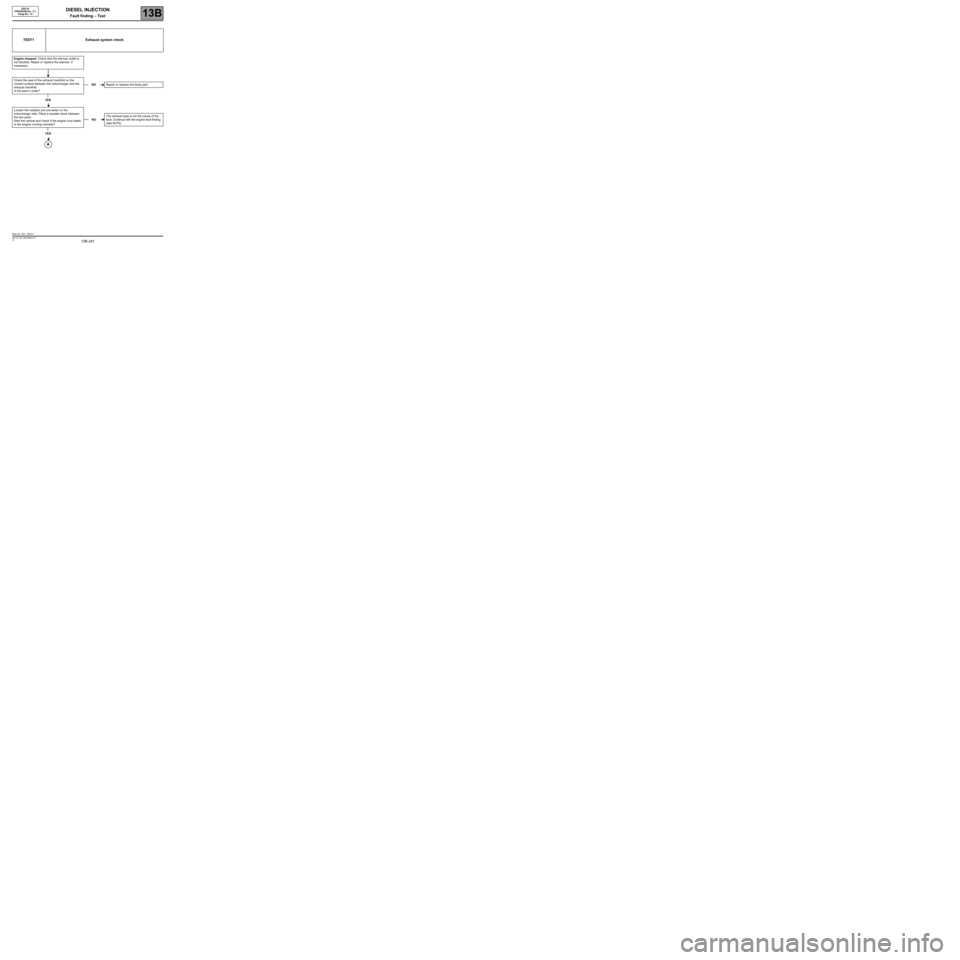
DIESEL INJECTION
Fault finding – Test13B
13B -241V3 MR-372-J84-13B250$900.mif
EDC16
PROGRAM No.: C1
Vdiag No.: 51
TEST1 Exhaust system check
Engine stopped: Check that the silencer outlet is
not blocked. Repair or replace the silencer, if
necessary.
Check the seal of the exhaust manifold on the
contact surface between the turbocharger and the
exhaust manifold.
Is the seal in order?
YES
Loosen the catalytic pre-converter on the
turbocharger side. Place a wooden block between
the two parts.
Start the vehicle and check if the engine runs better.
Is the engine running normally?
YES
NORepair or replace the faulty part.
NOThe exhaust pipe is not the cause of the
fault. Continue with the engine fault finding
(see ALP5).
EDC16_V51_TEST1